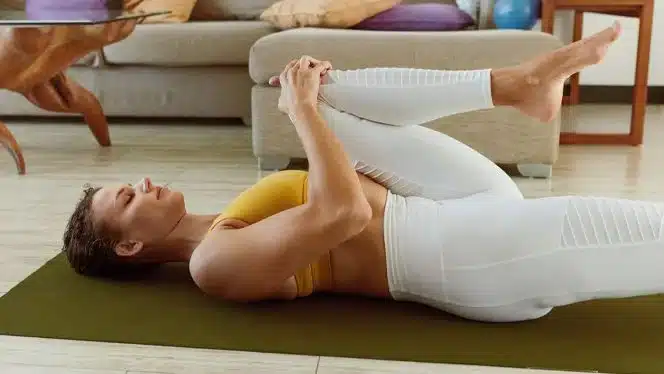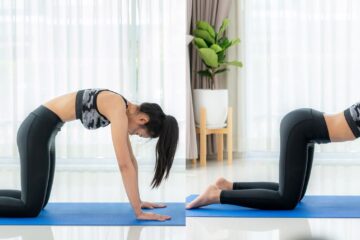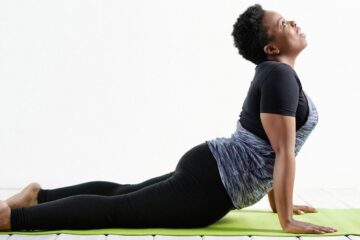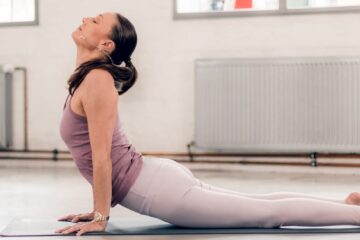Back pain is a common ailment that affects millions of people worldwide, often caused by sedentary lifestyles, poor posture, or stress.
While seeking medical advice is essential for chronic conditions, incorporating yoga into your routine can provide significant relief and help prevent future discomfort.
Yoga offers a holistic approach, combining physical postures, breathing techniques, and meditation to alleviate back pain.
In this article, we’ll explore ten yoga poses specifically designed to target and alleviate back pain.
Cat-Cow Pose (Marjaryasana-Bitilasana)
Begin on your hands and knees, aligning your wrists directly under your shoulders and your knees under your hips. Inhale as you arch your back, lifting your tailbone and chest towards the ceiling (Cow Pose).
Exhale as you round your spine, tucking your chin to your chest and drawing your belly button towards your spine (Cat Pose). Repeat this flow for several breaths, synchronizing movement with breath to warm up the spine and release tension.
Downward-Facing Dog (Adho Mukha Svanasana)
From a tabletop position, tuck your toes and lift your hips towards the ceiling, forming an inverted V-shape with your body. Press your hands firmly into the ground, keeping your arms straight and your ears in line with your upper arms.
Engage your core muscles and lengthen through your spine, gently pedaling your feet to stretch the calves and hamstrings. Downward-Facing Dog increases flexibility in the spine while strengthening the back muscles.
Child’s Pose (Balasana)
Sit back on your heels with your knees spread wide apart. Exhale as you lower your torso forward, extending your arms in front of you and resting your forehead on the mat.
Relax your entire body, allowing your spine to lengthen and your lower back to soften. Focus on deepening your breath and surrendering to the gentle stretch in your back and hips. Child’s Pose is a restorative posture that relieves tension in the lower back and promotes relaxation.
Cobra Pose (Bhujangasana)
Lie on your stomach with your palms planted beneath your shoulders and your elbows close to your body. Inhale as you gently lift your chest off the mat, using the strength of your back muscles while keeping your pelvis grounded.
Press the tops of your feet into the floor and lengthen through the crown of your head, opening your heart forward.
Avoid putting excessive pressure on your hands, and instead, engage your core to support your spine. Cobra Pose strengthens the muscles along the spine and improves posture.
Sphinx Pose (Salamba Bhujangasana)
Similar to Cobra Pose, begin by lying on your stomach with your elbows bent and forearms resting on the mat, parallel to each other.
Press your forearms into the ground as you lift your chest and head, elongating your spine. Keep your shoulders relaxed and draw your shoulder blades down your back to avoid tension in the neck.
Sphinx Pose gently stretches the abdomen and strengthens the back muscles, relieving discomfort in the lower back.
Forward Fold (Uttanasana)
Stand with your feet hip-width apart and hinge at your hips as you fold forward, bringing your torso towards your thighs.
Allow your head to hang heavy and grab onto opposite elbows, swaying gently from side to side to release tension in the spine.
Keep a slight bend in your knees to protect your hamstrings and lower back. Forward Fold lengthens the spine, stretches the hamstrings, and promotes relaxation.
Thread the Needle Pose (Parsva Balasana)
Start in a tabletop position, then slide your right arm underneath your left arm, lowering your right shoulder and ear to the mat.
Extend your left arm overhead or wrap it around your back, finding a gentle twist through the spine. Keep your hips squared and breathe deeply into the stretch, feeling the release in your upper back and shoulders.
Repeat on the other side. Thread the Needle Pose alleviates tension in the thoracic spine and improves mobility.
Supine Twist (Supta Matsyendrasana)
Lie on your back with your knees bent and feet flat on the floor. Extend your arms out to the sides in line with your shoulders. Exhale as you lower your knees to the right, twisting your spine and turning your head to the left.
Keep both shoulders grounded as you relax into the stretch, allowing gravity to deepen the twist. Hold for a few breaths, then switch sides. Supine Twist releases tightness in the lower back and hips, promoting spinal mobility.
Bridge Pose (Setu Bandhasana)
Lie on your back with your knees bent and feet hip-width apart. Press into your feet as you lift your hips towards the ceiling, engaging your glutes and thighs.
Interlace your hands beneath your lower back and roll your shoulders underneath you, lifting your chest towards your chin.
Keep your neck long and gaze towards your knees, breathing deeply into the chest and shoulders. Bridge Pose strengthens the back muscles, opens the chest, and improves spinal flexibility.
Legs Up the Wall Pose (Viparita Karani)
Sit next to a wall with your hips as close to the wall as possible. Lie on your back and extend your legs up the wall, keeping your arms relaxed by your sides.
Close your eyes and focus on your breath, allowing gravity to gently traction your spine and release tension. Stay in this pose for several minutes, allowing your body to surrender and relax completely.
Legs Up the Wall Pose improves circulation, relieves lower back tension, and promotes deep relaxation.
Conclusion
Yoga offers a powerful antidote to back pain by addressing the root causes of discomfort and promoting overall well-being.
By incorporating these ten yoga poses into your daily routine, you can alleviate tension, improve flexibility, and cultivate a stronger, healthier back.
Remember to listen to your body and modify poses as needed, and always consult with a healthcare professional before beginning any new exercise regimen, especially if you have pre-existing back issues. With dedication and practice, you can experience lasting relief and a newfound sense of ease in your body.




